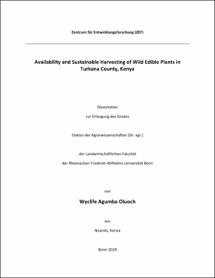Availability and Sustainable Harvesting of Wild Edible Plants in Turkana County, Kenya

Availability and Sustainable Harvesting of Wild Edible Plants in Turkana County, Kenya

| dc.contributor.advisor | Schmitt, Christine B. | |
| dc.contributor.author | Oluoch, Wyclife Agumba | |
| dc.date.accessioned | 2024-04-22T08:12:50Z | |
| dc.date.available | 2024-04-22T08:12:50Z | |
| dc.date.issued | 22.04.2024 | |
| dc.identifier.uri | https://hdl.handle.net/20.500.11811/11504 | |
| dc.description.abstract | Wild Edible Plants (WEPs) are important globally in alleviating poverty and malnutrition especially micronutrient deficiency within arid and semi-arid lands with limited potential for cultivate crops. However, they are underutilized, threatened by both natural and anthropogenic factors, and their distribution patterns are not well understood especially in regards to changing climate. Further, some communities are endowed with nutritious WEPs but still face acute malnutrition levels warranting the need to unravel how they perceive the availability of the plants for their use. Understanding how indigenous communities perceive availability of WEPs as well as threats and management options, could help in enhancing their conservation and foster their sustainable utilization for dietary diversification. This thesis uses integrated participatory approach involving local ecological knowledge from indigenous communities and scientific methods to explore availability and sustainable harvesting of WEPs in Turkana County, Kenya. Specifically, it assesses how Turkana communities perceive availability of WEPs, assesses threats and management options for the WEPs, and predicts the potentially suitable habitats for selected WEPs at present and under future projected climate scenarios. In that regard, it uses both mixed methods content analysis and species distribution modeling approaches. The findings emphasize the need for including local ecological knowledge in conservation and sustainable management efforts of WEPs. They also show the magnitude of impact of distribution and richness of WEPs in northwestern Kenya with similar patterns throughout Eastern Africa. They also contribute to improving national food policies and environmental conservation policies in Kenya to embrace more of WEPs and further evaluate their potential use in alleviating hunger and malnutrition in arid and semi-arid lands. | en |
| dc.language.iso | eng | |
| dc.rights | Namensnennung 4.0 International | |
| dc.rights.uri | http://creativecommons.org/licenses/by/4.0/ | |
| dc.subject.ddc | 630 Landwirtschaft, Veterinärmedizin | |
| dc.title | Availability and Sustainable Harvesting of Wild Edible Plants in Turkana County, Kenya | |
| dc.type | Dissertation oder Habilitation | |
| dc.publisher.name | Universitäts- und Landesbibliothek Bonn | |
| dc.publisher.location | Bonn | |
| dc.rights.accessRights | openAccess | |
| dc.identifier.urn | https://nbn-resolving.org/urn:nbn:de:hbz:5-75797 | |
| dc.relation.doi | https://doi.org/10.1007/s10745-022-00370-0 | |
| dc.relation.doi | https://doi.org/10.1186/s13002-023-00584-6 | |
| dc.relation.doi | https://doi.org/10.1007/s10113-023-02175-3 | |
| ulbbn.pubtype | Erstveröffentlichung | |
| ulbbnediss.affiliation.name | Rheinische Friedrich-Wilhelms-Universität Bonn | |
| ulbbnediss.affiliation.location | Bonn | |
| ulbbnediss.thesis.level | Dissertation | |
| ulbbnediss.dissID | 7579 | |
| ulbbnediss.date.accepted | 15.04.2024 | |
| ulbbnediss.institute | Zentrale wissenschaftliche Einrichtungen : Zentrum für Entwicklungsforschung (ZEF) | |
| ulbbnediss.fakultaet | Landwirtschaftliche Fakultät | |
| dc.contributor.coReferee | Borgemeister, Christian | |
| dcterms.hasSupplement | https://github.com/Wycology/wild_edible_plants_availability | |
| ulbbnediss.contributor.orcid | https://orcid.org/0000-0003-0803-9279 |
Files in this item
This item appears in the following Collection(s)
-
E-Dissertationen (1115)




